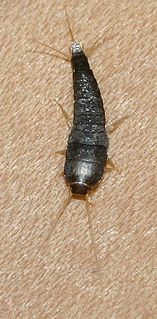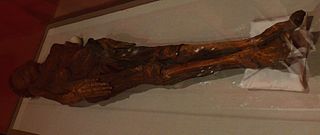
The Guanches were the aboriginal inhabitants of the Canary Islands. In 2017, the first genome-wide data from the Guanches confirmed a North African origin and that they were genetically most similar to ancient North African Berber peoples of the nearby North African mainland. It is believed that they may have arrived on the archipelago some time in the first millennium BC.
Guanche is an extinct language that was spoken by the Guanches of the Canary Islands until the 16th or 17th century. It died out after the conquest of the Canary Islands as the Guanche ethnic group was assimilated into the dominant Spanish culture. The Guanche language is known today through sentences and individual words that were recorded by early geographers, as well as through several place-names and Guanche words that were retained in the Canary Islanders' Spanish.

The First Battle of Acentejo took place on the island of Tenerife between the Guanches and an alliance of Spaniards, other Europeans, and associated natives, on 31 May 1494, during the Spanish conquest of this island. It resulted in a victory for the Guanches of Tenerife.

Lepismatidae is a family of primitive wingless insects with about 190 described species. This family contains the two most familiar members of the order Zygentoma: the silverfish and the firebrat. It is one of five families in the order Zygentoma.

Ctenolepisma is a genus of primitive insects in the order Zygentoma, closely related to the silverfish and firebrat but less reliant on human habitation, some species being found both indoors and outdoors and some found exclusively outdoors. The genus is distributed nearly worldwide in warm regions. Australia lacks native Ctenolepisma, but is home to introduced species.

Ctenolepisma lineatum is a species of insect of the order Zygentoma. It is generally similar to the closely related silverfish but can be distinguished by being rather stouter and less shiny with all appendages noticeably longer. The abdomen is often marked with dark brown lines and the species is sometimes called four-lined silverfish.
Canary Islanders, or Canarians, are a Romance people and subgroup of the Spaniards. They are indigenous to the Canary Islands, an autonomous community of Spain near the coast of northwest Africa, and descend from a mixture of Spanish settlers and aboriginal Guanche peoples. Genetic shows modern Canarian people to be a mixture of mostly European, with significant North African, and minor Sub-Saharan African. The distinctive variety of the Spanish language spoken in the region is known as habla canaria or the (dialecto) canario. The Canarians, and their descendants, played a major role during the conquest, colonization, and eventual independence movements of various countries in Latin America. Their ethnic and cultural presence is most palpable in the countries of Uruguay, Venezuela, Cuba, Dominican Republic, and the United States territory of Puerto Rico.
The Battle of Aguere, or Battle of San Cristóbal de La Laguna, was fought between forces of the Crown of Castile, led by the Adelantado Alonso Fernández de Lugo, and the natives of Tenerife, called Guanches. The battle took place on 14-15 November 1494.

Museo de la Naturaleza y Arqueología (MUNA), is a museum-based in Santa Cruz de Tenerife, Tenerife,. It contains many significant archaeological finds and is considered the best repository of objects from the Pre-Castilian Canary Islands. The museum also houses significant paleontological, botanical, entomological, and marine and terrestrial vertebrate collections, and is considered the best Natural Library of the Canary Islands.

Chaxiraxi is a goddess, known as the Sun Mother, in the religion of the aboriginal Guanche inhabitants of the Canary Islands. Chaxiraxi was one of the principal goddesses of the Guanche pantheon. She was associated with the star Canopus.
Magec, in Tenerife, was a deity in the ancient Berber mythology. He or she was god or goddess of the Sun and the light and also thought to be one of the principal divinities in Guanche religion. According to legend, Magec was captured by Guayota and held him or her prisoner inside Teide; Magec was later liberated by Achamán.
Achuhucanac is the rain god in Guanche religion in Tenerife, identified with the Supreme God (Achamán). Its name comes from: ašu_hu_kanak Guanche language that means "that is in the rain" or "that who is in the rain".

Guayota, in Guanche mythology of Tenerife, was the principal malignant deity and Achamán's adversary.

The Archaeological Museum of Puerto de la Cruz is a small archaeological museum located in the town of Puerto de la Cruz. One of the most important local museums, it offers an archival collection comprising more than 2,600 specimens of the aboriginal Guanche culture, and a document collection named after researcher Luis Diego Cuscoy.

Guanche mummies are the intentionally desiccated remains of members of the indigenous Berber Guanche people of the Tenerife. The Guanche mummies were made during the eras prior to Spanish settlement of the area in the 15th century. The methods of embalming are similar to those that were used by the Ancient Egyptians, though fewer mummies remain from the Guanche due to looting and desecration.

The conquest of the Canary Islands by the Crown of Castille took place between 1402 and 1496. It can be divided into two periods: the Conquista señorial, carried out by Castilian nobility in exchange for a covenant of allegiance to the crown, and the Conquista realenga, carried out by the Spanish crown itself, during the reign of the Catholic Monarchs.

The Church of the Guanche People is a religious organisation, founded in 2001 in the city of San Cristóbal de La Laguna, Tenerife, Canary Islands, Spain. It aims to perpetuate and spread the traditional religion of the ancient Guanche people.

The Cave of the Guanches, or Archaeological area of the Cave of the Guanches, is an important archaeological site located in the north of the island of Tenerife.

The Caves of Don Gaspar is an important archaeological site located in the north of the island of Tenerife.
Cuban nationality law is regulated by the Constitution of Cuba, currently the 2019 Constitution, and to a limited degree upon Decree 358 of 1944. These laws determine who is, or is eligible to be, a citizen of Cuba. Cuban citizenship is typically obtained either on the principle of jus soli, i.e. by birth in Cuba; or under the rules of jus sanguinis, i.e. by birth abroad to a parent with Cuban nationality. It can also be granted to a permanent resident who has lived in the country for a given period of time through naturalization.












